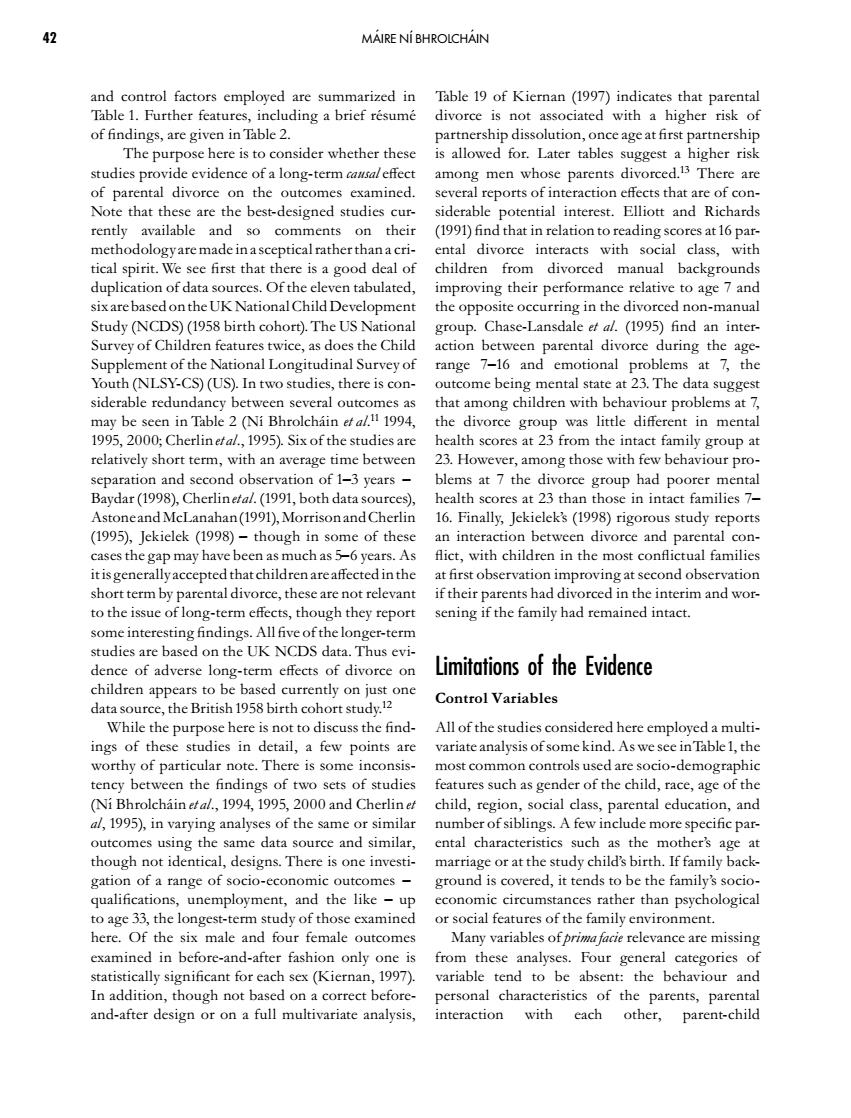正在加载图片...

42 MAIRE NI BHROLCHAIN and control factors employed are summarized in Table 19 of Kiernan (1997)indicates that parental Table 1.Further features,including a brief resume divorce is not associated with a higher risk of of findings,are given in Table 2. partnership dissolution,once age at first partnership The purpose here is to consider whether these is allowed for.Later tables suggest a higher risk studies provide evidence of a long-term causal effect among men whose parents divorced.13 There are of parental divorce on the outcomes examined. several reports of interaction effects that are of con- Note that these are the best-designed studies cur- siderable potential interest.Elliott and Richards rently available and so comments on their (1991)find that in relation to reading scores at 16 par- methodologyare made in asceptical rather than a cri- ental divorce interacts with social class,with tical spirit.We see first that there is a good deal of children from divorced manual backgrounds duplication of data sources.Of the eleven tabulated,improving their performance relative to age 7 and six are based on the UK National Child Development the opposite occurring in the divorced non-manual Study (NCDS)(1958 birth cohort).The US National group.Chase-Lansdale et al.(1995)find an inter- Survey of Children features twice,as does the Child action between parental divorce during the age- Supplement of the National Longitudinal Survey of range 7-16 and emotional problems at 7,the Youth (NLSY-CS)(US).In two studies,there is con- outcome being mental state at 23.The data suggest siderable redundancy between several outcomes as that among children with behaviour problems at 7, may be seen in Table 2(Ni Bhrolchain efal.1 1994,the divorce group was little different in mental 1995,2000;Cherlinefal.,1995).Six of the studies are health scores at 23 from the intact family group at relatively short term,with an average time between 23.However,among those with few behaviour pro- separation and second observation of 1-3 years- blems at 7 the divorce group had poorer mental Baydar(1998),Cherlinetal.(1991,both data sources),health scores at 23 than those in intact families 7- Astoneand McLanahan(1991),MorrisonandCherlin 16.Finally,Jekielek's(1998)rigorous study reports (1995),Jekielek (1998)-though in some of these an interaction between divorce and parental con- cases the gap may have been as much as 5-6 years.As flict,with children in the most conflictual families it is generally accepted that children areaffected in the at first observation improving at second observation short term by parental divorce,these are not relevant if their parents had divorced in the interim and wor- to the issue of long-term effects,though they report sening if the family had remained intact. some interesting findings.All five of the longer-term studies are based on the UK NCDS data.Thus evi- dence of adverse long-term effects of divorce on Limitations of the Evidence children appears to be based currently on just one data source,the British 1958 birth cohort study.12 Control Variables While the purpose here is not to discuss the find-All of the studies considered here employed a multi- ings of these studies in detail,a few points are variate analysis of some kind.As we see in Table 1,the worthy of particular note.There is some inconsis- most common controls used are socio-demographic tency between the findings of two sets of studies features such as gender of the child,race,age of the (Ni Bhrolchain etal.,1994,1995,2000 and Cherlin et child,region,social class,parental education,and al,1995),in varying analyses of the same or similar number of siblings.A few include more specific par- outcomes using the same data source and similar,ental characteristics such as the mother's age at though not identical,designs.There is one investi-marriage or at the study child's birth.If family back- gation of a range of socio-economic outcomes- ground is covered,it tends to be the family's socio- qualifications,unemployment,and the like-up economic circumstances rather than psychological to age 33,the longest-term study of those examined or social features of the family environment. here.Of the six male and four female outcomes Many variables of primafacie relevance are missing examined in before-and-after fashion only one is from these analyses.Four general categories of statistically significant for each sex(Kiernan,1997).variable tend to be absent:the behaviour and In addition,though not based on a correct before- personal characteristics of the parents,parental and-after design or on a full multivariate analysis, interaction with each other,parent-child
0 5 % F
M
M
5 9 5
3
<
?
1
< )
#<)
* #%&-'
* 5
<
)
)
< J
,
#<J
,)
* #
* !
5 9 #<LM 7
M
%% %&&C %&&- 9:::( )
%&&-*
%>=
> 7 #%&&'* )
#%&&%
* +
6J
#%&&%*6
)
#%&&-* H"" #%&&'* >
->E
+
3
3
+
<)
5
3
/
7
%&-'
%9 ?
5
#<LM 7
M
%&&C %&&- 9::: )
%&&-*
5
>
" > ==
1
#
%&&.* !
5 %&
#%&&.*
"
J
"
%= 5
3
I
#%&&%*
%E
"
.
)
J
#%&&-*
.>%E
.
9= 5
.
3
9=
9= $
.
9=
.> %E F H""4
#%&&'*
B
B
8
+
" +
5%
+
4
4
! "
4
6
F
A
����������������������������������������������������������������������������������������������������������������������������������������������������������������������������������������������������������������������������������������������������������������������������������������������������������������������������������������������